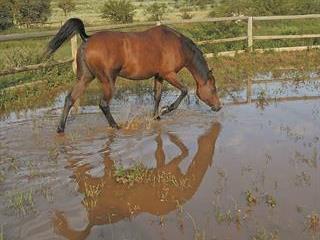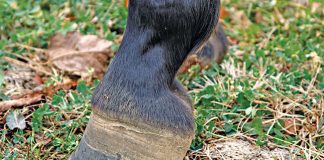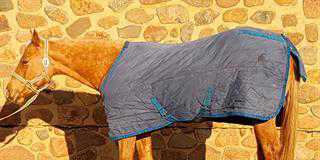
Horses are prey animals – they have survived by being wary of situations they do not understand. When you lead or ride a horse through water for the first time, the horse has no way of knowing how deep or dangerous the obstacle is. Only a horse that has learnt to trust its rider will approach a scary situation with confidence.
When doing ground work on a young horse, it’s a good idea to get it used to walking through water. This is fairly easy if you live in a wet part of the country, but on the Highveld horses and their owners are not likely to see puddles on the ground between May and September.
However, building confidence in crossing such obstacles is still possible with a tarpaulin making a good substitute for a puddle. Weigh the edges down so that the horse’s hooves do not get caught underneath, frightening it even further.
Coming upon a strange obstacle for the first time, a horse is likely to ‘spook’. A sudden release of adrenalin will cause it to go rigid, or jump sideways. You should anticipate this happening and always wear a riding helmet and closed shoes when working with young horses, in case they jump onto you.
Habituation
As the horse becomes rigid, reassure it, using a calm tone, or even feed it carrots until it relaxes. Place some lucerne hay at the edge of the tarpaulin and encourage the horse to get its nose down to explore it.
Behaviourists have different approaches to desensitising or habituating horses, but the basic principles are the same. Build confidence gradually and reward the horse for being relaxed. The advantage of using carrots or lucerne is that once the horse starts eating, it goes from the fight-or-flight adrenalin mode to the para-sympathetic state as its digestive system is activated.
It’s also better to start with a challenge that’s easily overcome, such as a narrow tarpaulin, and progress gradually to a wider one. The whole point of habituation is to employ the same method each time to encourage the horse to trust you when it encounters a strange obstacle.
On the trail
Despite habituation during ground work, a horse might still spook when it encounters a real stream or muddy patch for the first time. This can be dangerous as the horse can unseat you if it wheels away, bucks or rears.
If you feel the horse becoming rigid, sit up straight and reassure it. Don’t lean forward or grab at the reins – rather let it examine the obstacle and slowly relax. Next, turn its head away from the obstacle and slowly walk in circles, away and back again. Turn away from the stream as soon as you start to feel the horse tensing up. Pause now and then, just before you turn away and let the horse get another good look at the water.
Be patient. Encourage the horse to go forward with your voice, hands and legs. An older horse that can lead the way is often the best solution. Under no circumstances should you use a whip or shout. That will raise the horse’s adrenalin level and is likely to cause it to associate water with an unpleasant experience in future.
If all else fails, dismount and lead the horse across.
Dr Mac is an academic, a practising equine veterinarian and a stud owner.













